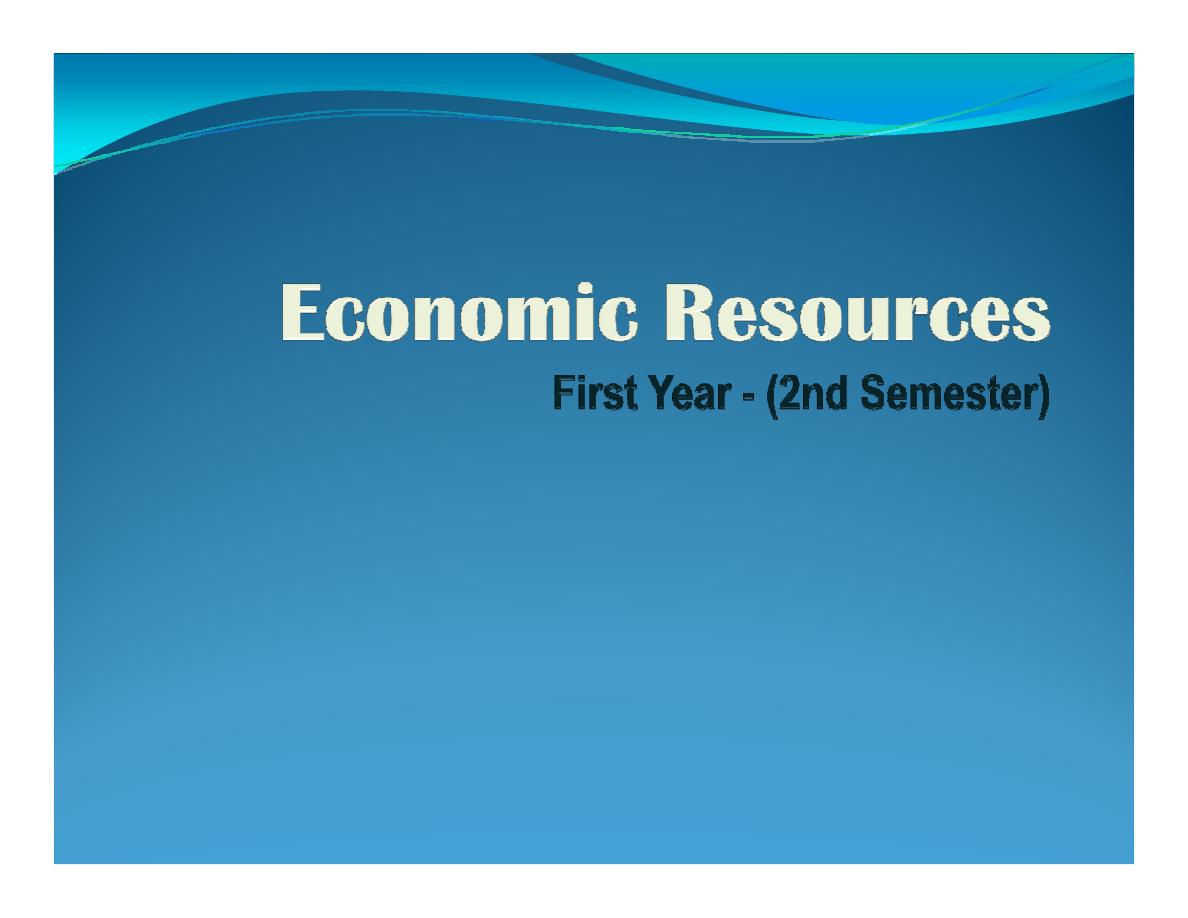
Dr/
Dr/ Hebatallah
Hebatallah ADAM
ADAM
Associate Professor of Economics
Faculty of Commerce Ain Shams University

Chapter 5
Agricultural Resources*
2
Dr/ Hebatallah ADAM - Economics Resources - 2015

I. Factors affecting agriculture resources
1.
Increase in population
2.
Agricultural land degradation and water scarcity
3.
Climate change
4.
Energy market impacts on agriculture
Dr/ Hebatallah ADAM - Economics Resources - 2015
3

I. Factors affecting agriculture resources (cont'd)
1.
Increase in population
In the absence of reasonable population limits, the main
challenges of agriculture will be to increase production.
2.
Agricultural land degradation and water scarcity
Water scarcity may reduce yields by an additional 5–25%. It
may be the most powerful crop yield reducer.
Dr/ Hebatallah ADAM - Economics Resources - 2015
4

I. Factors affecting agriculture resources (cont'd)
3.
Climate change
The impacts of Climate Change on Agriculture are
basically:
a.
Hydrologic: The hydrologic cycle now includes more frequent
a.
Hydrologic: The hydrologic cycle now includes more frequent
and intense droughts and floods in many agricultural regions.
b.
Heat: Over the next 30-50 years, average temperatures will
likely increase by at least 1.0 °C.
c.
CO2: Over the next 30-50 years, CO2 concentrations will
increase to about 450 parts per million by volume (ppmv).
Dr/ Hebatallah ADAM - Economics Resources - 2015
5

I. Factors affecting agriculture resources (cont'd)
d.
Economic Consequences: Price will rise for the most
important agricultural crops (rice, wheat, maize, and
soybeans). This, in turn, leads to higher feed and therefore
meat prices. As a result, climate change will lead to greater food
insecurity.
4.
Energy market impacts on agriculture
Growing demands for energy are adding further pressures on
agricultural systems, both to supply traditional bio-energy and
to supply industrial bio-fuels.
Dr/ Hebatallah ADAM - Economics Resources - 2015
6

II. Agriculture and growth in developing countries
At the macro-economic level, growth in agriculture has been
consistently shown to be more beneficial to the poor than growth
in other sectors.
Four ‘transmission mechanisms’ critically link changes in
Four ‘transmission mechanisms’ critically link changes in
agricultural performance to progress in reducing poverty:
1.
Direct and relatively immediate impact of improved agricultural
performance on rural incomes;
2.
Impact of cheaper food for both urban and rural poor;
Dr/ Hebatallah ADAM - Economics Resources - 2015
7

II. Agriculture and growth in developing countries
(cont'd)
3.
Agriculture’s contribution to growth and the generation of
economic opportunity in the non-farm sector;
4.
Agriculture’s fundamental role in stimulating and
sustaining economic transition, as countries shifts away
from being primarily agricultural towards a broader base
of manufacturing and services.
Dr/ Hebatallah ADAM - Economics Resources - 2015
8

III. Agriculture and Food Security
Food security exists when all people, at all times, have
physical, social and economic access to sufficient safe and
healthful food that meets their dietary needs and food
preferences for an active and healthy life.
preferences for an active and healthy life.
To achieve food security, the following four dimensions
must be considered:
1.
Food availability: The availability of sufficient quantities of
food of appropriate quality.
Dr/ Hebatallah ADAM - Economics Resources - 2015
9

III. Agriculture and Food Security (cont'd)
2.
Food access: Access by individuals to adequate resources for
acquiring appropriate foods for a healthful diet.
3.
Utilization: Utilization of food through adequate diet, clean
water, sanitation and health care.
water, sanitation and health care.
4.
Stability: Population must have access to adequate food at
all times. They should not risk losing access to food as a
consequence of sudden shocks (e.g. an economic or climatic
crisis) or cyclical events (e.g. seasonal food insecurity).
Dr/ Hebatallah ADAM - Economics Resources - 2015
10

Thank You
Thank You
Dr/ Hebatallah ADAM - Economics Resources - 2015
11

* Reference:
Farag Ezzat & Hebatallah Adam, (2015),
“Economics
Resources”,
Ain
Shams
University, Faculty of Commerce, Part II -
University, Faculty of Commerce, Part II -
Chapter 5: “Agriculture Resources”, pp. (1-
45).
Dr/ Hebatallah ADAM - Economics Resources - 2015
12
